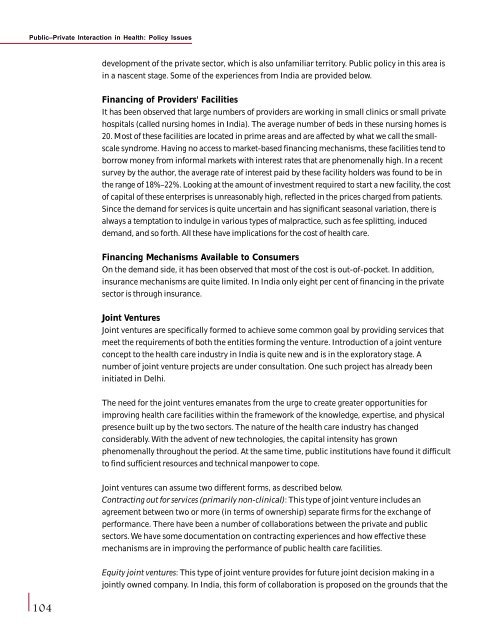Health Policy Issues and Health Programmes in ... - Amazon S3
Health Policy Issues and Health Programmes in ... - Amazon S3
Health Policy Issues and Health Programmes in ... - Amazon S3
- No tags were found...
You also want an ePaper? Increase the reach of your titles
YUMPU automatically turns print PDFs into web optimized ePapers that Google loves.
Public–Private Interaction <strong>in</strong> <strong>Health</strong>: <strong>Policy</strong> <strong>Issues</strong>development of the private sector, which is also unfamiliar territory. Public policy <strong>in</strong> this area is<strong>in</strong> a nascent stage. Some of the experiences from India are provided below.F<strong>in</strong>anc<strong>in</strong>g of Providers’ FacilitiesIt has been observed that large numbers of providers are work<strong>in</strong>g <strong>in</strong> small cl<strong>in</strong>ics or small privatehospitals (called nurs<strong>in</strong>g homes <strong>in</strong> India). The average number of beds <strong>in</strong> these nurs<strong>in</strong>g homes is20. Most of these facilities are located <strong>in</strong> prime areas <strong>and</strong> are affected by what we call the smallscalesyndrome. Hav<strong>in</strong>g no access to market-based f<strong>in</strong>anc<strong>in</strong>g mechanisms, these facilities tend toborrow money from <strong>in</strong>formal markets with <strong>in</strong>terest rates that are phenomenally high. In a recentsurvey by the author, the average rate of <strong>in</strong>terest paid by these facility holders was found to be <strong>in</strong>the range of 18%–22%. Look<strong>in</strong>g at the amount of <strong>in</strong>vestment required to start a new facility, the costof capital of these enterprises is unreasonably high, reflected <strong>in</strong> the prices charged from patients.S<strong>in</strong>ce the dem<strong>and</strong> for services is quite uncerta<strong>in</strong> <strong>and</strong> has significant seasonal variation, there isalways a temptation to <strong>in</strong>dulge <strong>in</strong> various types of malpractice, such as fee splitt<strong>in</strong>g, <strong>in</strong>duceddem<strong>and</strong>, <strong>and</strong> so forth. All these have implications for the cost of health care.F<strong>in</strong>anc<strong>in</strong>g Mechanisms Available to ConsumersOn the dem<strong>and</strong> side, it has been observed that most of the cost is out-of-pocket. In addition,<strong>in</strong>surance mechanisms are quite limited. In India only eight per cent of f<strong>in</strong>anc<strong>in</strong>g <strong>in</strong> the privatesector is through <strong>in</strong>surance.Jo<strong>in</strong>t VenturesJo<strong>in</strong>t ventures are specifically formed to achieve some common goal by provid<strong>in</strong>g services thatmeet the requirements of both the entities form<strong>in</strong>g the venture. Introduction of a jo<strong>in</strong>t ventureconcept to the health care <strong>in</strong>dustry <strong>in</strong> India is quite new <strong>and</strong> is <strong>in</strong> the exploratory stage. Anumber of jo<strong>in</strong>t venture projects are under consultation. One such project has already been<strong>in</strong>itiated <strong>in</strong> Delhi.The need for the jo<strong>in</strong>t ventures emanates from the urge to create greater opportunities forimprov<strong>in</strong>g health care facilities with<strong>in</strong> the framework of the knowledge, expertise, <strong>and</strong> physicalpresence built up by the two sectors. The nature of the health care <strong>in</strong>dustry has changedconsiderably. With the advent of new technologies, the capital <strong>in</strong>tensity has grownphenomenally throughout the period. At the same time, public <strong>in</strong>stitutions have found it difficultto f<strong>in</strong>d sufficient resources <strong>and</strong> technical manpower to cope.Jo<strong>in</strong>t ventures can assume two different forms, as described below.Contract<strong>in</strong>g out for services (primarily non-cl<strong>in</strong>ical): This type of jo<strong>in</strong>t venture <strong>in</strong>cludes anagreement between two or more (<strong>in</strong> terms of ownership) separate firms for the exchange ofperformance. There have been a number of collaborations between the private <strong>and</strong> publicsectors. We have some documentation on contract<strong>in</strong>g experiences <strong>and</strong> how effective thesemechanisms are <strong>in</strong> improv<strong>in</strong>g the performance of public health care facilities.104Equity jo<strong>in</strong>t ventures: This type of jo<strong>in</strong>t venture provides for future jo<strong>in</strong>t decision mak<strong>in</strong>g <strong>in</strong> ajo<strong>in</strong>tly owned company. In India, this form of collaboration is proposed on the grounds that the







